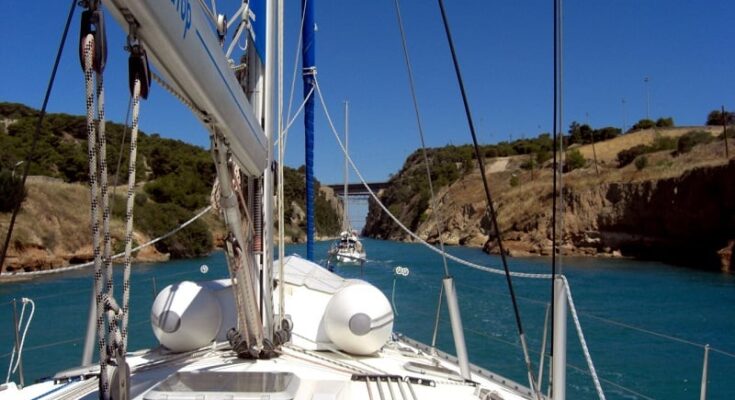What is it like sailing through the Corinth Canal? British expatriates Tony and Tessa Cross describe a fascinating experience. The Greek engineering marvel temporarily reopened for three months Thursday, June 1, 2023, after the landslides of 2021. The British couple spent years living on their yacht while crisscrossing the Aegean.
By Tony Cross
The Corinth Canal is one of the wonders of the modern world. It’s impressive when viewed from one of the road bridges that cross the canal, but when viewed from a yacht in the canal itself it’s simply breathtaking.
We’ve been fortunate to travel through the canal twice in our sailing yacht Little Roundtop and in both directions.
A little history of the Corinth Canal
The Isthmus of Corinth is a tantalizingly narrow piece of land that separates the Gulf of Corinth from the Saronic Gulf. For any ships wanting to travel between the Ionian and the Aegean, finding a way across the narrow isthmus would spare one a long trip around the Peloponnese.
As far back as 600 BC, ships were dragged across the isthmus on cradles on a specially constructed stone road.
Although the idea of a canal was first proposed around 300 BC, it was the Roman Emperor Nero who initiated the first serious attempts to dig a canal in 67 AD. He completed only about 700 meters (2,296 feet), a little more than a tenth of the distance required.
The modern canal, which follows the same route as Nero’s canal—and thus obliterated all traces of it—was begun in 1881 and completed in 1893. It didn’t open for traffic until the following year, however, because of problems with the stability of the walls.
The canal is 6.4 kilometers (3.4 nautical miles) long, 25 meters (82 feet) wide at sea level, and 8 meters (26 feet) deep. It runs in a rough northwest to southeast direction.
Unfortunately, the size of cargo ships increased quite quickly after the canal had been opened, and they soon began to outgrow the 25-meter width of the canal. Today it is used only by smaller cargo ships, cruise ships, pleasure boats, and tourist vessels.
In October 2019, the cruise ship MS Braemar, with a length of almost 196 meters and a beam just short of 23 meters, became the largest vessel ever to pass through the Corinth Canal.
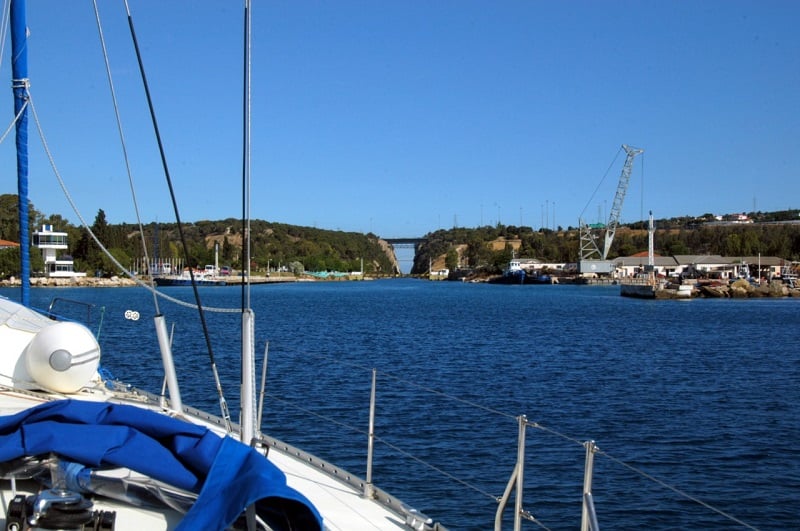
Arriving at the Corinth Canal
The control tower and a small quay are at the eastern end of the canal opposite Isthmia, so vessels passing westwards towards the Gulf of Corinth can moor to the quay and pay at the control tower.
The cost varies depending on the type of vessel and its length. For our 14 meter private sailing yacht we paid a little over €233, including VAT. That works out at around €68 per mile and almost certainly makes the Corinth Canal the most expensive stretch of water in the world!
Traffic in the canal runs in only one direction at a time of course, so you have to wait for eastbound traffic to exit before they will let the westbound traffic go. There is a submersible bridge at each end of the canal which they raise and lower to control the flow of traffic in the canal.
As we waited for the eastbound traffic to exit, we saw that the last vessel through was a sizeable cargo ship. One of the canal workers on shore shouted to everyone “watch your lines!” The bow wave that larger ships push before them has nowhere to go in the canal, so it forms a tiny tsunami in front of the ship.
As the cargo ship passed us, all of the small yachts on the quay were tossed around like toys.
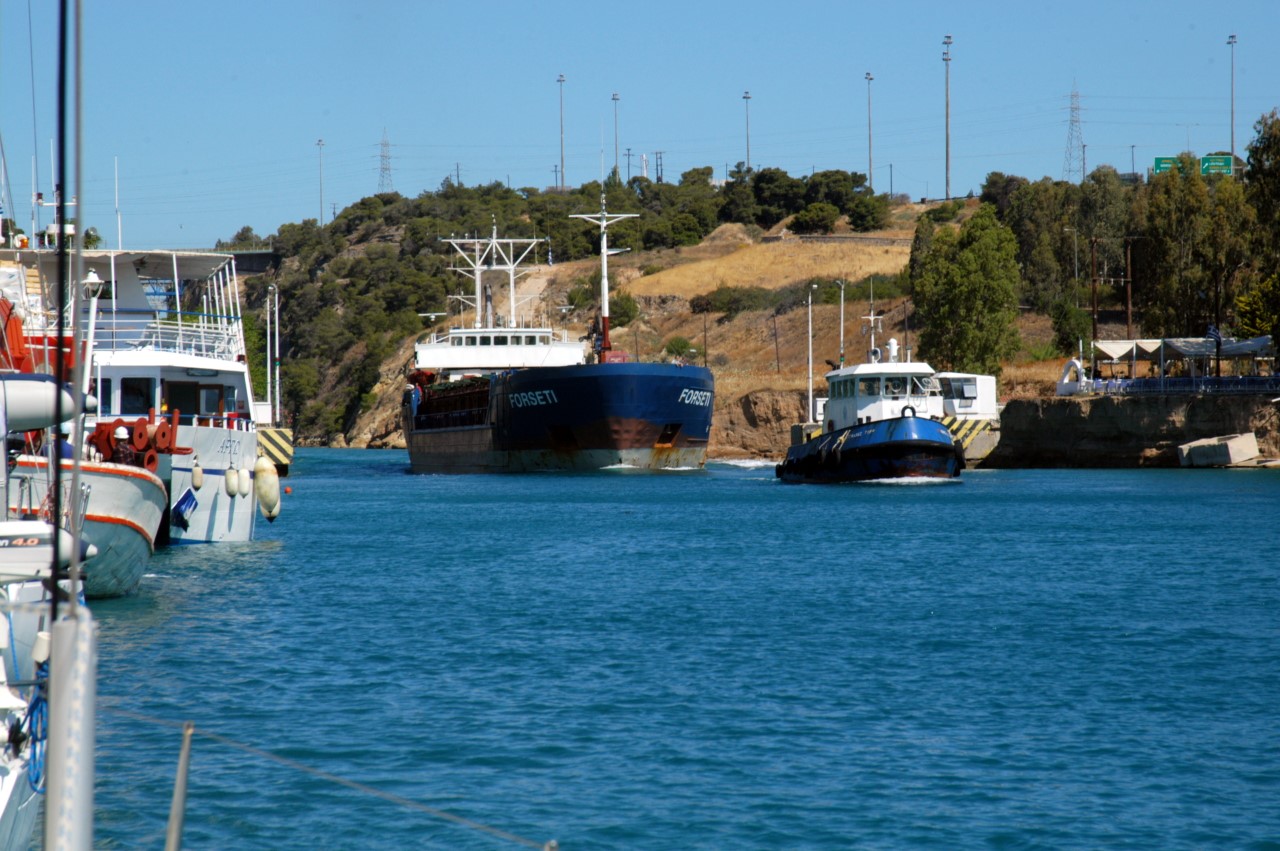
Thanks to the warning shout from the canal worker almost everyone managed to keep their boats safe and secure, though a yacht astern of us very nearly crashed into us.
Setting off
When you check in and pay, they tell you in which order to enter the canal; generally, they put the faster vessels at the front and the slower vessels at the back. Because they want traffic to pass through the canal as fast as possible, you are supposed to make a minimum speed of 6 knots. You also have to keep your VHF radio on channel 11; the canal control seems to only use this to constantly tell everyone to go faster!

As we all set off, a lone sailor in a small German-flagged yacht didn’t seem to want to wait his turn at the back, and he rushed off as fast as he could, trying to get ahead in line. We couldn’t figure out why he’d bother, as the view is the same wherever you are in the order of yachts!
His impatience turned out to be a blessing for us, however. He ended up just in front of us, and it turned out that his small yacht could barely make five knots. Since overtaking in the canal is forbidden, we had a much more leisurely view of the canal than we would otherwise have had despite the near-constant calls from the control tower for me to “go faster!”
Sailing in the canal
The canal is arrow-straight, so there is no difficulty in steering the yacht and admiring the view at the same time. Not running over the small yacht in front was a bit more of a challenge, however! With occasional use of the autopilot, it’s even possible to take photos.
The eastern end of the canal is fairly low and the walls slowly rise to tower above you where the road bridges cross (the maximum height of the walls is 79 meters). We could see lots of people on the bridges watching us so we waved at them, and they all waved back!
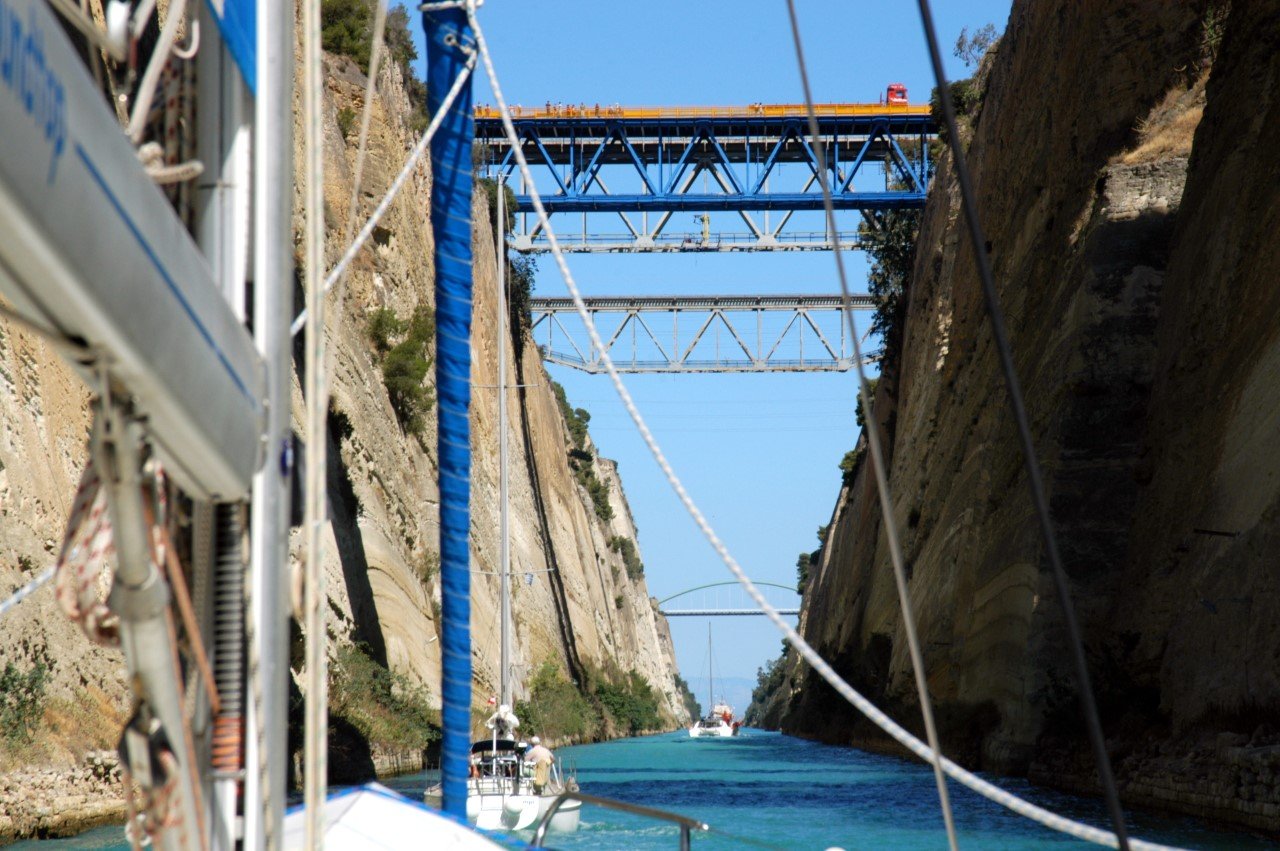
The famous aerial views you see of the canal are of this higher central section. At one point here, it’s also possible to see the hand and foot holds cut into the rock by the men who built it.

At water level, the canal has been lined with stone blocks in places, presumably to protect these weaker sections; elsewhere, the wash of even small yachts undermines the soft limestone walls, the site of many recent landslides, and a few old and larger ones are clearly visible. It’s not hard to see why the canal suffers so many landslides and blockages.

Once past all the bridges, the walls of the canal gradually reduce in height again. By the time you reach the western end, the walls are only a little above sea level and the transition from canal to open sea would pass almost unnoticed were it not for the black and yellow stripes on the submersible bridge, which thankfully was submerged at the time!
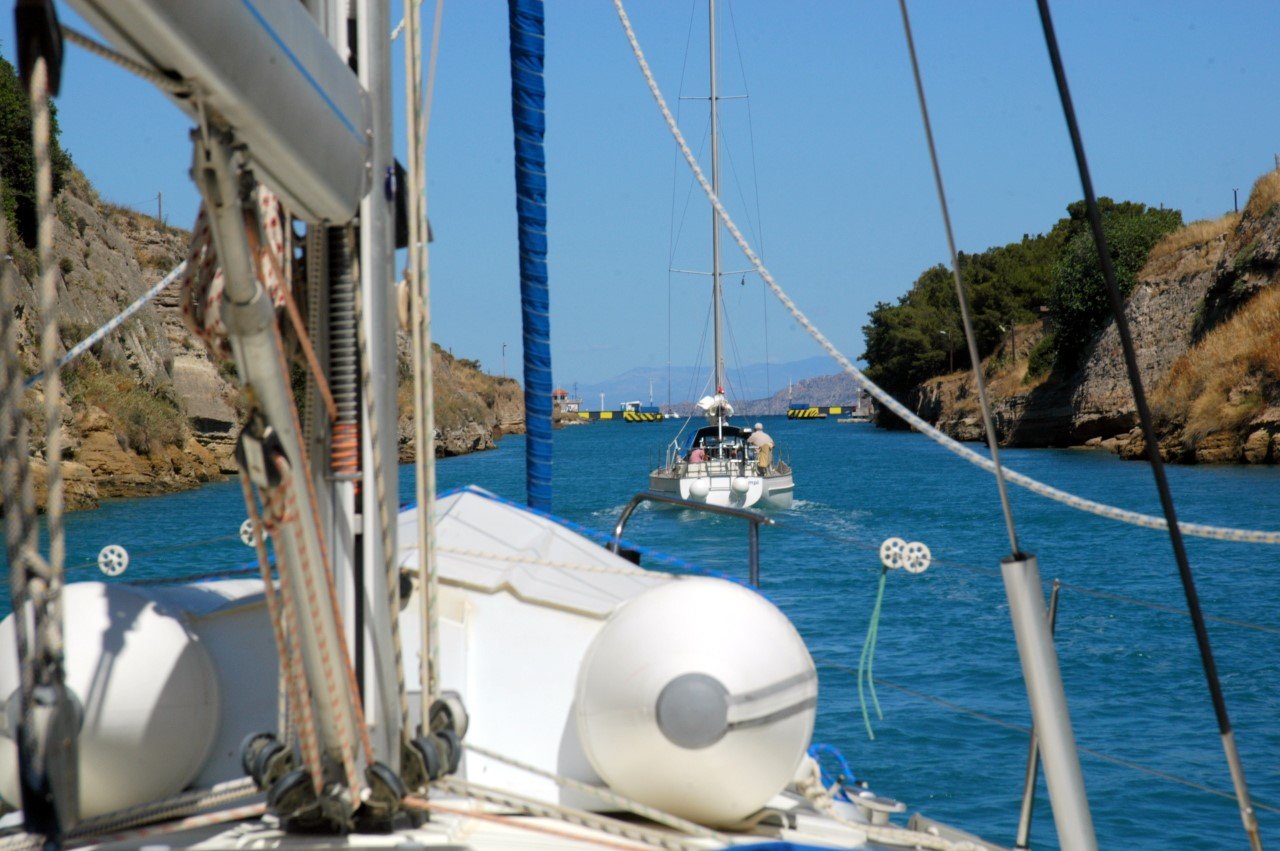
Sailing eastwards through the Corinth canal
If you’re in the Gulf of Corinth looking to travel eastward through the canal, things are a little more complex. There is no quay at the western end of the canal. Rather there is only an enclosed basin in which waiting is forbidden.
You have to call the canal control on VHF channel 11 so that they know you’re there. They do have cameras, of course, but you still have to call to make your intentions clear.
The canal was not open to eastbound traffic when we arrived, and the submersible bridge was in its raised position blocking the canal, so we had to wait. Since it can take 45 minutes to an hour for all westbound traffic to clear the canal, we anchored a safe distance to the north of the canal.
We knew from our previous trip through that they don’t leave much time when they turn the canal direction round, so as soon as we saw vessels exiting the canal, we raised anchor and just motored around out of the way until we were called in.
There were a couple of other yachts hanging around the western entrance as well in addition to us, and since there was nobody to tell us in which order to enter, we sorted our order out by mutual consent and a lot of “after you” arm waving!
On our eastbound trip we were again constantly assaulted by canal control telling us over the radio to go faster. I wondered whether it was a recording on a loop that they just play every time?
Once you reach the eastern end of the canal, you have to moor to the quay and pay at the control tower. They have a very fast patrol boat moored here to chase those who try to avoid paying.
If you don’t have your own boat
When we were moored to the quay at the eastern end of the canal, we noticed a number of tourist coaches arriving and leaving. These bring tourists to a couple of large tripper boats that do nothing other than motor up and down the canal. If you don’t have your own boat, then this is one way to experience the canal from sea level.
I strongly recommend it because travelling through the Corinth Canal is an unforgettable experience.
